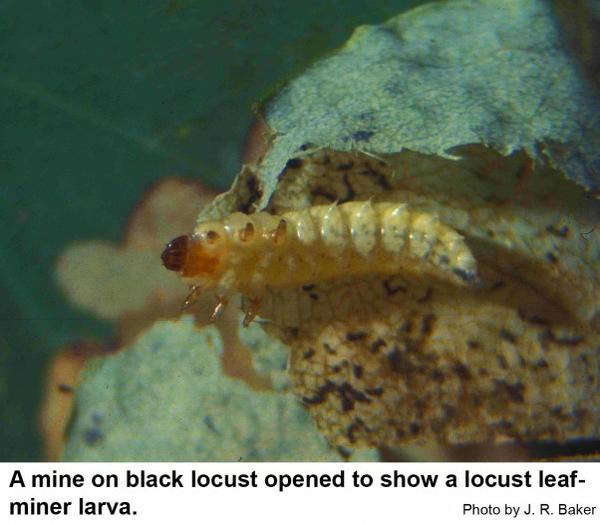Description and Biology
Locust leafminers, Odontota dorsalis, are small, elongate, flat beetles, about ¼ inch long. The head is black and the wing covers are orange with a broad black or brown stripe down the center. The wing covers are deeply pitted and have three long ridges each. Full-grown larvae are yellowish, flat, and slightly longer than adults. Locust leafminers have one or two generations per year. Locust leafminers overwinter as beetles in bark crevices and leaf litter. They emerge in spring about the time leaves start to unfold to feed on the lower leaf surfaces where they also lay eggs. The eggs overlap like shingles in groups of three to five and are cemented together by excrement. Upon hatching, the tiny new larvae feed inside that leaflet. Later the larvae leave to mine other leaflets. One larva may mine several leaflets before it matures. Larvae pupate within the translucent mines in July. There are two generations per year. Several parasites and predators attack the locust leafminer, which may explain why it does not maintain large populations in one area for long.
Host Plants
Locust leaf miners prefer to mine the leaves of black locust but they have been reported from honey locust and a few other trees as well. Apple, beech, birch, cherry, elm, oak, and hawthorn are occasionally attacked. Outbreaks of this leafminer occur almost every year throughout the range of black locust, but seldom affect the same trees for more than a couple of years. Sometimes the damage is quite noticeable with acres of black locusts turning brown by mid summer. A few years ago we had a minor outbreak here in Raleigh that nobody noticed because black locust is mostly a weed tree here (however, it does make a fine shade tree). If trees are severely defoliated by locust leafminers and other stress factors are present, such trees may die.
Residential Recommendation
In a landscape the best time to spray a pesticide is in late May or early June when the adult locust leafminers are active and the larval mines are less than ¼ inch long. An insecticide with some systemic activity such as Orthene or imidacloprid will give the best control.
References
- Locust Leafminer Odontota dorsalis (Thunberg). Hanson, T., and E. B. Walker. No Date. Field guide to common insect pests of urban trees in the Northeast. Waterbury, VT: Department of Forests, Parks and Recreation.
- Locust Leafminer, Coleoptera: Chrysomelidae: Odontota dorsalis (Thunberg). Day, E. 2011 (revised T. A. Dellinger 2022). Pub. No. 3101-1528. Virginia Coop. Extension, Virginia Tech, VSU.
- Insects of Eastern Forests. Drooz, A. 1985. USDA Forest Service Misc. Pub. 1426. 608 pp.
- Extension Plant Pathology Publications and Factsheets
- Horticultural Science Publications
- North Carolina Agricultural Chemicals Manual
For assistance with a specific problem, contact your local N.C. Cooperative Extension center.
This Factsheet has not been peer reviewed.
Publication date: Dec. 18, 2013
Reviewed/Revised: Nov. 3, 2023
Recommendations for the use of agricultural chemicals are included in this publication as a convenience to the reader. The use of brand names and any mention or listing of commercial products or services in this publication does not imply endorsement by NC State University or N.C. A&T State University nor discrimination against similar products or services not mentioned. Individuals who use agricultural chemicals are responsible for ensuring that the intended use complies with current regulations and conforms to the product label. Be sure to obtain current information about usage regulations and examine a current product label before applying any chemical. For assistance, contact your local N.C. Cooperative Extension county center.
N.C. Cooperative Extension prohibits discrimination and harassment regardless of age, color, disability, family and marital status, gender identity, national origin, political beliefs, race, religion, sex (including pregnancy), sexual orientation and veteran status.





